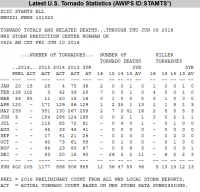
Add the 26 preliminary tornado reports since last Friday and the count for June should become 35. Wow...a whole 35 reports through a little over half the month.
Hey, at least we had an average May...except when you consider the 239 preliminary count is already below the average actual count of 259 and will likely decrease somewhat when reports are confirmed/denied. So May likely wasn't even truly average by count.
Getting serious now...
Most would argue that a small number of quality tornadoes is as good as, or better than, a large number of low quality tornadoes. There have been a handful of quality tornadoes this year, all in May (7th near Wray, 9th in southern OK, 24th in Dodge City, and 25th northeast of Salina). If you caught some, or all, of those, you probably are having a good year. I happened to have missed every single one of those, even though three of them were reachable reasonably to me. I know I'm not alone there. So as far as I'm concerned (and I think this has support from others in the chasing community), this year has been another one worth barfing at. I will also continue to argue until my jaw hurts that at least the events of the 9th and 24th had atypically low predictability, and probably the 25th as well, so those events were not generally the classic type of Plains severe weather/tornado event that can be seen coming a few days out. So in that regard, I think that makes this season even worse than the aggregate counts suggest.
